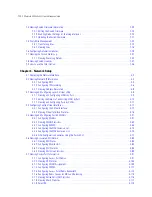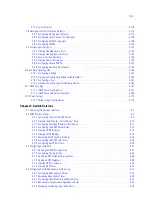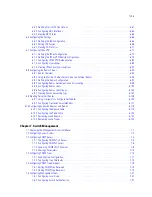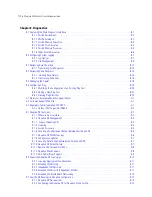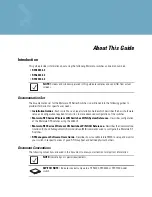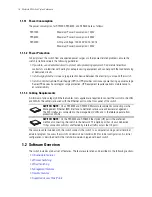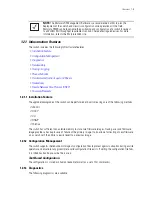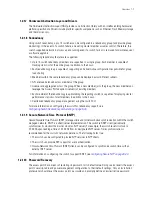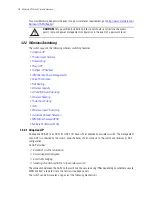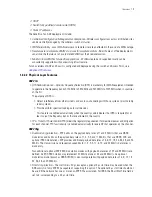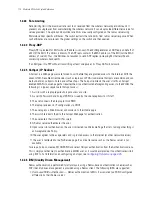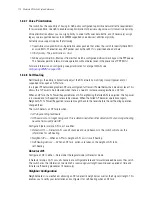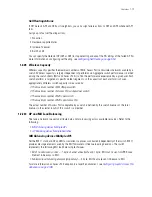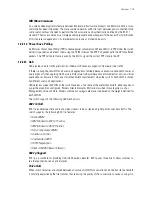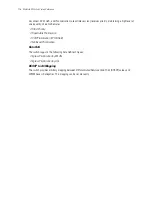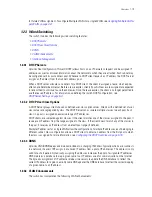
1-6
Motorola RF Switch Systen Reference
1.
In-service Diagnostics
– In-service diagnostics provide a range of automatic health monitoring features
ensuring both the system hardware and software are in working order. In-service-diagnostics
continuously monitor available physical characteristics (as detailed below) and issue log messages when
warning or error thresholds are reached. There are three types of in-service diagnostics:
•
Hardware
– Ethernet ports, chip failures, system temperature via the temperature sensors provided
by the hardware, etc.
•
Software
– CPU load, memory usage, etc.
•
Environmental
– CPU and air temperature, fans speed, etc.
2. Out-of-service Diagnostics – Out-of-service diagnostics are a set of intrusive tests run from the user
interface. Out-of-service diagnostics cannot be run while the switch is in operation. Intrusive tests
include:
• Ethernet loopback tests
• RAM tests, Real Time Clock tests, etc.
3. Manufacturing Diagnostics – Manufacturing diagnostics are a set of diagnostics used by manufacturing
to inspect quality of hardware.
1.2.1.4 Serviceability
A special set of Service CLI commands are available to provide additional troubleshooting capabilities for
service personnel (access to Linux services, panic logs, etc.). Only authorized users or service personnel are
provided access to the Service CLI.
A built-in Packet Sniffer enables service personnel and users to capture incoming and outgoing packets in a
buffer.
The switch also collects statistics for RF activity, Ethernet port activity etc. RF statistics include roaming
stats, packet counters, octets tx/rx, signal, noise SNR, retry, and information for each MU.
1.2.1.5 Tracing / Logging
Log messages are well-defined and documented system messages with various destinations. They are
numbered and referenced by ID. Each severity level group, can be configured separately to go to either the
serial console, telnet interface, log file or remote syslog server.
Trace messages are more free-form and are used mainly by support personnel for tracking problems. They
are enabled or disabled via CLI commands. Trace messages can go to a log file, the serial console, or the
current tty.
Log and trace messages are interleaved in the same log file, so chronological order is preserved. Log and
trace messages from different processes are similarly interleaved in the same file for the same reason.
Log message format is similar to the format used by syslog messages (RFC 3164). Log messages include
message severity, source (facility), the time the message was generated and a textual message describing
the situation triggering the event. For more information on using the switch logging functionality, see
Configuring System Logging on page 8-7
.
1.2.1.6 Process Monitor
The switch Process Monitor checks to ensure processes under its control are up and running. Each monitored
process sends periodic heartbeat messages. A process that is down (due to a software crash or stuck in an
endless loop) is detected when its heartbeat is not received. Such a process is terminated (if still running)
and restarted (if configured) by the Process Monitor.
Содержание RFS Series
Страница 1: ...M Motorola RFS Series Wireless LAN Switches WiNG System Reference Guide ...
Страница 10: ...TOC 8 Motorola RF Switch System Reference Guide ...
Страница 56: ...2 8 Motorola RF Switch System Reference ...
Страница 334: ...5 52 Motorola RF Switch System Reference 2 Select the MU Status tab ...
Страница 510: ...7 32 Motorola RF Switch System Reference Guide ...
Страница 534: ...8 24 Motorola RF Switch System Reference Guide ...
Страница 570: ...C 14 Motorola RF Switch System Reference Guide ...
Страница 589: ......
Страница 590: ...MOTOROLA INC 1303 E ALGONQUIN ROAD SCHAUMBURG IL 60196 http www motorola com 72E 132942 01 Revision C December 2010 ...

